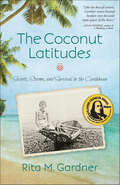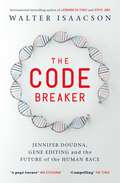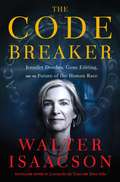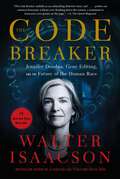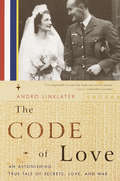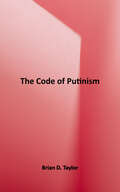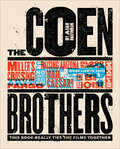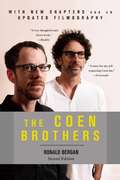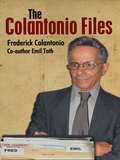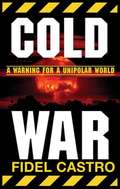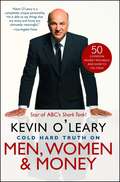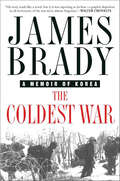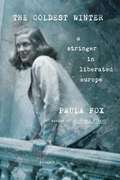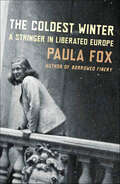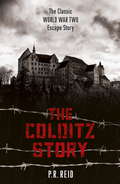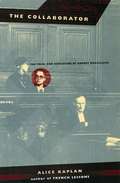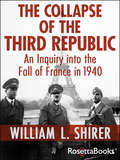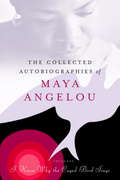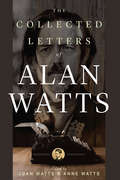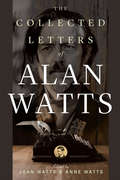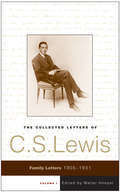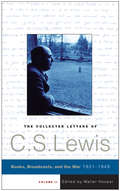- Table View
- List View
The Coconut Latitudes: Secrets, Storms, and Survival in the Caribbean
by Rita M. GardnerGold Medal Winner, Autobiography/Memoir, 2015 IBPA Benjamin Franklin Awards. A father makes the fateful decision to leave a successful career in the US behind and move to an isolated beach in the Dominican Republic. He plants ten thousand coconut seedlings, transplants his wife and two young daughters to a small village, and declares they are the luckiest people alive. In reality, the family is in the path of hurricanes and in the grip of a brutal dictator, Rafael Trujillo—and the children are additionally under the thumb of an increasingly volatile and alcoholic father. Set against a backdrop of shimmering palms and kaleidoscope sunsets, The Coconut Latitudes is Rita Gardner’s compelling memoir of a childhood in paradise, a journey into unexpected misery, and a twisted path to redemption and truth.
The Code Breaker: Jennifer Doudna, Gene Editing, And The Future Of The Human Race
by Walter IsaacsonThe best-selling author of Leonardo da Vinci and Steve Jobs returns. In 2012, Nobel Prize winning scientist Jennifer Doudna hit upon an invention that will transform the future of the human race: an easy-to-use tool that can edit DNA. Known as CRISPR, it opened a brave new world of medical miracles and moral questions. It has already been deployed to cure deadly diseases, fight the coronavirus pandemic of 2020, and make inheritable changes in the genes of babies. But what does that mean for humanity? Should we be hacking our own DNA to make us less susceptible to disease? Should we democratise the technology that would allow parents to enhance their kids? After discovering this CRISPR, Doudna is now wrestling these even bigger issues. THE CODE BREAKERS is an examination of how life as we know it is about to change – and a brilliant portrayal of the woman leading the way.
The Code Breaker: Jennifer Doudna, Gene Editing, and the Future of the Human Race
by Walter IsaacsonThe bestselling author of Leonardo da Vinci and Steve Jobs returns with a gripping account of how the pioneering scientist Jennifer Doudna, along with her colleagues and rivals, launched a revolution that will allow us to cure diseases, fend off viruses, and enhance our children. In the spring of 2012, the Berkeley biochemist Jennifer Doudna and her collaborators turned a curiosity of nature into an invention that will transform the future of the human race: an easy-to-use tool that can edit DNA. Known as CRISPR, it opened a brave new world of medical miracles and moral questions. It has already been deployed to cure deadly diseases, fight the coronavirus pandemic of 2020, and make inheritable changes in the genes of babies. The development of CRISPR and the war against coronavirus will hasten our transition to the next great innovation revolution. The past half-century has been an information-technology era, based on the microchip, the computer, and the internet. Now we are entering an even more momentous era, a life-science revolution. Children who study digital coding will be surpassed by those who study the code of life. Should we use our new evolution-hacking powers to make us less susceptible to viruses and eliminate dreaded disorders? What a wonderful boon that would be! Right? And what about preventing congenital deafness or blindness? Or being very short? Or being depressed? Hmmm…How should we think about that? Should we allow parents, if they can afford it, to enhance the IQ or height or memory or muscles of their kids? After helping to discover CRISPR, Doudna became a leader in wrestling with these moral and policy issues. Her life story illustrates that the key to innovation is connecting basic science to our everyday lives—moving discoveries from our labs to our bedsides—in ways that respect our moral values. It&’s a thrilling detective tale that involves the most profound wonders of nature, from the origins of life to the future of our species.
The Code Breaker: Jennifer Doudna, Gene Editing, and the Future of the Human Race
by Walter IsaacsonThe bestselling author of Leonardo da Vinci and Steve Jobs returns with a gripping account of how Nobel Prize winner Jennifer Doudna and her colleagues launched a revolution that will allow us to cure diseases, fend off viruses, and have healthier babies. <P><P>When Jennifer Doudna was in sixth grade, she came home one day to find that her dad had left a paperback titled The Double Helix on her bed. She put it aside, thinking it was one of those detective tales she loved. When she read it on a rainy Saturday, she discovered she was right, in a way. As she sped through the pages, she became enthralled by the intense drama behind the competition to discover the code of life. Even though her high school counselor told her girls didn’t become scientists, she decided she would. <P><P>Driven by a passion to understand how nature works and to turn discoveries into inventions, she would help to make what the book’s author, James Watson, told her was the most important biological advance since his co-discovery of the structure of DNA. She and her collaborators turned a curiosity of nature into an invention that will transform the human race: an easy-to-use tool that can edit DNA. Known as CRISPR, it opened a brave new world of medical miracles and moral questions. The development of CRISPR and the race to create vaccines for coronavirus will hasten our transition to the next great innovation revolution. The past half-century has been a digital age, based on the microchip, computer, and internet. Now we are entering a life-science revolution. Children who study digital coding will be joined by those who study genetic code. Should we use our new evolution-hacking powers to make us less susceptible to viruses? What a wonderful boon that would be! And what about preventing depression? Hmmm…Should we allow parents, if they can afford it, to enhance the height or muscles or IQ of their kids? <P><P> After helping to discover CRISPR, Doudna became a leader in wrestling with these moral issues and, with her collaborator Emmanuelle Charpentier, won the Nobel Prize in 2020. Her story is a thrilling detective tale that involves the most profound wonders of nature, from the origins of life to the future of our species. <P><P><b>A New York Times Bestseller</b>
The Code of Love: An Astonishing True Tale of Secrets, Love, and War
by Andro LinklaterFor fifty years, Pamela Kirrage longed to unlock the secrets of her husband’s encrypted war diary. She was on the verge of giving up when she at last found a mathematician who became as obsessed with learning the secrets of the diary as she was. After months of painstaking investigation, he was finally able to crack the code, and in the process uncover the ending to an extraordinary World War II romance. Pamela fell in love with RAF pilot Donald Hill in the summer of 1939, just a few months before he was sent to fight in Pacific. Although they planned to marry soon, Donald was captured after siege of Hong Kong and spent the next four years in a Japanese POW camp. Donald ultimately returned to Pamela, but he was never able to tell her about those lost years–and Pamela became convinced that the key to their happiness lay within the mysterious diary he brought back from the war. InThe Code of LoveAndro Linklater uses the decoded diary as well as extensive research and interviews to paint a vivid portrait of the World War II era, turning this dramatic love story into an inspiring, unconventional epic.
The Code of Putinism
by Brian D. TaylorWhat is Vladimir Putin up to? This book shows how the mentality of Putin and his team - the code of Putinism - has shaped Russian politics over the past two decades. It explains not only the thoughts and ideas that motivate Putin's decisions, but also the set of emotions and habits that influence how Putin and his close allies view the world. <p><p>The code of Putinism has powerfully shaped the nature of Russia's political system, its economy, and its foreign policy. Taylor draws on a large number of interviews, the speeches of Putin and other top officials, and the Russian media to analyze the mentality of Team Putin. Key features of Russian politics today -- such as authoritarianism, Putin's reliance on a small group of loyal friends and associates, state domination of the economy, and an assertive foreign policy - are traced to the code of Putinism. <p><p>Key ideas of the code include conservatism, anti-Americanism, and the importance of a state that is powerful both at home and abroad. Dominant habits of Putin and his associates include control, order, and loyalty. Important feelings driving Russia's rulers include the need for respect, resentment about lost status and mistreatment by the West, and vulnerability. <p><p>While some observers portray Putin as either a cold-blooded pragmatist or a strident Russian nationalist, Taylor provides a more nuanced and compelling interpretation of Putin's motives and actions. The Code of Putinism also shows how Putin's choices, guided by this mentality, have led to a Russia that is misruled at home and punching above its weight abroad.
The Coen Brothers (Text-only Edition): This Book Really Ties the Films Together
by Adam NaymanFans of Fargo, The Big Lebowski, No Country for Old Men, and other modern classics will enjoy this “definitive history of the Coen brothers oeuvre” (Indiewire).From such cult hits as Raising Arizona (1987) and The Big Lebowski (1998) to major critical darlings Fargo (1996), No Country for Old Men (2007), and Inside Llewyn Davis (2013), Ethan and Joel Coen have cultivated a bleakly comical, instantly recognizable voice in modern American cinema. In The Coen Brothers: This Book Really Ties the Films Together, film critic Adam Nayman carefully sifts through their complex cinematic universe in an effort to plot, as he puts it, “some Grand Unified Theory of Coen-ness.” With a combination of biography, close analysis, and enlightening interviews with key Coen collaborators, this book honors the films’ singular mix of darkness and levity, and is the definitive exploration of the Coen brothers’ oeuvre.
The Coen Brothers Second Edition
by Ronald BerganBrought completely up to date, this insightful biography remains "a must for any self-respecting Coen fan" (Screentrade). This fully updated edition of the first biography of the Coen Brothers includes their complete work so far, from Blood Simple to Inside Llewyn Davis (2013), with a reassessment of their remarkable career as a whole. Joel and Ethan Coen have pulled off the ultimate balancing act. Despite having their movies financed and distributed by major studios, they have managed to remain true independents, rejecting commercial clichés and never giving up on their own fiercely idiosyncratic vision. While doing so, they have established themselves among the world's leading filmmakers. From their startling debut, Blood Simple (1984), all of their movies reveal a distinctive stamp: a flamboyant visual style, richly conceived characters, crisp dialogue, and brilliant casting. They have revitalized old Hollywood genres such as noir, screwball, and the western, giving them a contemporary sensibility. In this biography, Ronald Bergan traces the brothers' Jewish roots, their beginnings as film geeks in suburban Minneapolis, their battle to get their first feature made and released, through their early features and the movies of their maturity. He gives blow-by-blow accounts of the making of each movie. New chapters cover all those released since O Brother, Where Art Thou? (2000), with which the first edition of this book ended.
The Colantonio Files
by Frederick ColantonioThe people I’ve met in my life were the impetus for writing this book. They are the good, bad and ugly people. Those I remember the most are those who were good to me and helped me along the way to become a professional broadcaster and newspaper journalist. Others were not kind and often said aloud that I would fail at achieving my goals. One relative went so far as to ask “Why can't you hold a job?" He knew nothing of how unstable the job market was at the time for the jobs I held. It did not deter me; it fueled my desire to succeed. I knew what I wanted out of life and that is what I am currently doing. Mark Twain once said "A man is a crank until his idea succeeds and then is no longer a crank." The people I have dealt with in life were neighbors, relatives and working associates. Some are critical even at the writing of this book. Some were bullies who picked on me from the time I could walk until I hit the age of 21 years old. Some have already died. It all comes out in the wash as my Irish grandfather, Harry J. Joyce used to tell me. Sadly many who were unkind to me were unwilling to help people in need. Coffins don't have pockets was a phrase my parents often used. My mother said to me that she had two words of wisdom for me. They were not ‘thank you those two words were BE NICE. It is the legacy I want to leave behind.
The Cold War
by Fidel CastroInterviewed by CNN for the television series "The Cold War," Cuban President Fidel Castro provided his perspective on the Cold War in a wide-ranging discussion. Castro offers a number of historical revelations in his discussion of the Cuban Revolution, relationships with the Soviet Union and the United States, the Cuban Missile Crisis, U.S.-Latin American relations as a whole, and the fall of the Soviet Union. Castro concludes that the United States won the Cold War at the expense of the Socialist Bloc and the third world, but that socialism will eventually triumph globally. Distributed by Consortium Book Distribution. Annotation ©2004 Book News, Inc., Portland, OR (booknews.com)
The Cold, Hard Truth On Men, Women, and Money: 50 Common Money Mistakes and How to Fix Them
by Kevin O'LearyFrom bestselling author and television superstar Kevin O'Leary comes a new financial guide that takes you through money mistakes at every stage of life and teaches you how to avoid them. DON'T SPEND TOO MUCH. MOSTLY SAVE. ALWAYS INVEST. This is simple advice, but it's often the simple advice that's easy to swallow and hard to follow. Kevin O'Leary understands that getting a handle on your personal finances can be challenging at any age. Whether you're a parent struggling to explain savings to your children, a student contemplating a big loan to pay for school, a newly engaged couple considering joint bank accounts, or a baby boomer entering retirement, Kevin offers solid, practical advice to help you make and keep more money. As a lead shark on ABC's "Shark Tank," Kevin's success with money management and in business is legendary. But he's made mistakes along the way, too, and he's written this book so others can benefit from his experiences and learn how to avoid debt, how to save money, and how to invest for a brighter future. Each chapter is geared to a specific age or stage in life and looks closely at your relationship with money and how simple changes in thinking and decision-making can result in more cold hard cash in your wallet or bank account. You'll find real-life examples of common money mistakes and strategies for avoiding them, "Cold Hard Truth" quizzes and charts aimed at boosting your financial wisdom, and tips and tricks for making more money and growing it faster to achieve financial freedom.
The Coldest War: A Memoir of Korea
by James BradyJames Brady's The Coldest War is a powerful and moving memoir of the Korean War. America's "forgotten war" lasted just thirty-seven months, yet 54,246 Americans died in that time -- nearly as many as died in ten years in Vietnam. On the fiftieth anniversary of this devastating conflict, James Brady tells the story of his life as a young marine lieutenant in Korea.In 1947, seeking to avoid the draft, nineteen-year-old Jim Brady volunteered for a Marine Corps program that made him a lieutenant in the reserves on the day he graduated college. He didn't plan to find himself in command of a rifle platoon three years later facing a real enemy, but that is exactly what happened after the Chinese turned a so-called police action into a war.The Coldest War vividly describes Brady's rapid education in the realities of war and the pressures of command. Opportunities for bold offensives sink in the miasma of trench warfare; death comes in fits and starts as too-accurate artillery on both sides seeks out men in their bunkers; constant alertness is crucial for survival, while brutal cold and a seductive silence conspire to lull soldiers into an often fatal stupor.The Korean War affected the lives of all Americans, yet is little known beyond the antics of "M*A*S*H." Here is the inside story that deserves to be told, and James Brady is a powerful witness to a vital chapter of our history.
The Coldest Winter: A Stringer in Liberated Europe
by Paula FoxA Washington Post Book World Critic's Choice of the Year In this elegant and affecting follow-up to her extraordinary memoir, Borrowed Finery, a young writer travels through a Europe ravaged by the Second World War.
The Coldest Winter: A Stringer in Liberated Europe
by Paula FoxIn this elegant and affecting companion to her "extraordinary" memoir, Borrowed Finery, a young writer flings herself into a Europe ravaged by the Second World War (The Boston Globe) In 1946, Paula Fox walked up the gangplank of a partly reconverted Liberty with the classic American hope of finding experience—or perhaps salvation—in Europe. She was twenty-two years old, and would spend the next year moving among the ruins of London, Warsaw, Paris, Prague, Madrid, and other cities as a stringer for a small British news service. In this lucid, affecting memoir, Fox describes her movements across Europe's scrambled borders: unplanned trips to empty castles and ruined cathedrals, a stint in bombed-out Warsaw in the midst of the Communist election takeovers, and nights spent in apartments here and there with distant relatives, friends of friends, and in shabby pensions with little heat, each place echoing with the horrors of the war. A young woman alone, with neither a plan nor a reliable paycheck, Fox made her way with the rest of Europe as the continent rebuilt and rediscovered itself among the ruins. Long revered as a novelist, Fox won over a new generation of readers with her previous memoir, Borrowed Finery. Now, with The Coldest Winter, she recounts another chapter of a life seemingly filled with stories—a rare, unsentimental glimpse of the world as seen by a writer at the beginning of an illustrious career.
The Colditz Story
by Major P ReidColditz was the last stop for prisoners of war during WWII. Those who persisted in escaping from other camps were sent to the impregnable fortress of Colditz Castle, situated on a rocky outcrop high above the River Mulde. Once within the walls of the castle, the Germans reasoned, escape was impossible. And yet many prisoners attempted escape and many succeeded Pat Reid was one of those men. Appointed 'Escape Officer' by his fellow inmates, he masterminded many of the attempts. From tunnelling, to hiding in rubbish sacks, disguising themselves as German officers and even leaping from the castle walls, nothing was too dangerous or foolhardy compared to imprisonment by the enemy. Reid's own escape, in 1942, was both one of the most simple and the most daring. First published in 1952, The Colditz Story is a classic escape story in the tradition of The Great Escape and The Wooden Horse.
The Colditz Story
by Major R ReidColditz was the last stop for prisoners of war during WWII. Those who persisted in escaping from other camps were sent to the impregnable fortress of Colditz Castle, situated on a rocky outcrop high above the River Mulde. Once within the walls of the castle, the Germans reasoned, escape was impossible. And yet many prisoners attempted escape and many succeeded Pat Reid was one of those men. Appointed 'Escape Officer' by his fellow inmates, he masterminded many of the attempts. From tunnelling, to hiding in rubbish sacks, disguising themselves as German officers and even leaping from the castle walls, nothing was too dangerous or foolhardy compared to imprisonment by the enemy. Reid's own escape, in 1942, was both one of the most simple and the most daring. First published in 1952, The Colditz Story is a classic escape story in the tradition of The Great Escape and The Wooden Horse.
The Collaboration
by Ben UrwandTo continue doing business in Germany after Hitler's ascent to power, Hollywood studios agreed not to make films that attacked the Nazis or condemned Germany's persecution of Jews. Ben Urwand reveals this bargain for the first time--a "collaboration" (Zusammenarbeit) that drew in a cast of characters ranging from notorious German political leaders such as Goebbels to Hollywood icons such as Louis B. Mayer. At the center of Urwand's story is Hitler himself, who was obsessed with movies and recognized their power to shape public opinion. In December 1930, his Party rioted against the Berlin screening of All Quiet on the Western Front, which led to a chain of unfortunate events and decisions. Fearful of losing access to the German market, all of the Hollywood studios started making concessions to the German government, and when Hitler came to power in January 1933, the studios--many of which were headed by Jews--began dealing with his representatives directly. Urwand shows that the arrangement remained in place through the 1930s, as Hollywood studios met regularly with the German consul in Los Angeles and changed or canceled movies according to his wishes. Paramount and Fox invested profits made from the German market in German newsreels, while MGM financed the production of German armaments. Painstakingly marshaling previously unexamined archival evidence, The Collaboration raises the curtain on a hidden episode in Hollywood--and American--history.
The Collaborator: The Trial and Execution of Robert Brasillach (Studies In Law And Economics Ser.)
by Alice KaplanOn February 6, 1945, Robert Brasillach was executed for treason by a French firing squad. He was a writer of some distinction—a prolific novelist and a keen literary critic. He was also a dedicated anti-Semite, an acerbic opponent of French democracy, and editor in chief of the fascist weekly Je Suis Partout, in whose pages he regularly printed wartime denunciations of Jews and resistance activists. Was Brasillach in fact guilty of treason? Was he condemned for his denunciations of the resistance, or singled out as a suspected homosexual? Was it right that he was executed when others, who were directly responsible for the murder of thousands, were set free? Kaplan's meticulous reconstruction of Brasillach's life and trial skirts none of these ethical subtleties: a detective story, a cautionary tale, and a meditation on the disturbing workings of justice and memory, The Collaborator will stand as the definitive account of Brasillach's crime and punishment. A National Book Award Finalist A National Book Critics Circle Award Finalist "A well-researched and vivid account."—John Weightman, New York Review of Books "A gripping reconstruction of [Brasillach's] trial."—The New Yorker "Readers of this disturbing book will want to find moral touchstones of their own. They're going to need them. This is one of the few works on Nazism that forces us to experience how complex the situation really was, and answers won't come easily."—Daniel Blue, San Francisco Chronicle Book Review "The Collaborator is one of the best-written, most absorbing pieces of literary history in years."—David A. Bell, New York Times Book Review "Alice Kaplan's clear-headed study of the case of Robert Brasillach in France has a good deal of current-day relevance. . . . Kaplan's fine book . . . shows that the passage of time illuminates different understandings, and she leaves it to us to reflect on which understanding is better."—Richard Bernstein, The New York Times
The Collapse of the Third Republic: An Inquiry into the Fall of France in 1940
by William L. ShirerThe National Book Award–winning historian&’s &“vivid and moving&” eyewitness account of the fall of France to Hitler&’s Third Reich at the outset of WWII (The New York Times). As an international war correspondent and radio commentator during World War II, William L. Shirer didn&’t just research the fall of France. He was there. In just six weeks, he watched the Third Reich topple one of the world&’s oldest military powers—and institute a rule of terror and paranoia. Based on in-person conversations with the leaders, diplomats, generals, and ordinary citizens who both shaped the events and lived through them, Shirer constructs a compelling account of historical events without losing sight of the human experience. From the heroic efforts of the Freedom Fighters to the tactical military misjudgments that caused the fall and the daily realities of life for French citizens under Nazi rule, this fascinating and exhaustively documented account brings this significant episode of history to life. &“This is a companion effort to Shirer&’s The Rise and Fall of the Third Reich, also voluminous but very readable, reflecting once again both Shirer&’s own experience and an enormous mass of historical material well digested and assimilated.&” —Kirkus Reviews (starred review)
The Collected Autobiographies of Maya Angelou
by Maya AngelouNEW YORK TIMES BESTSELLER • Maya Angelou&’s classic memoirs have had an enduring impact on American literature and culture. Her life story is told in the documentary film And Still I Rise, as seen on PBS&’s American Masters.This Modern Library edition contains I Know Why the Caged Bird Sings, Gather Together in My Name, Singin&’ and Swingin&’ and Gettin&’ Merry Like Christmas, The Heart of a Woman, All God&’s Children Need Traveling Shoes, and A Song Flung Up to Heaven. When I Know Why the Caged Bird Sings was published to widespread acclaim in 1969, Maya Angelou garnered the attention of an international audience with the triumphs and tragedies of her childhood in the American South. This soul-baring memoir launched a six-book epic spanning the sweep of the author&’s incredible life. Now, for the first time, all six celebrated and bestselling autobiographies are available in this handsome one-volume edition. Dedicated fans and newcomers alike can follow the continually absorbing chronicle of Angelou&’s life: her formative childhood in Stamps, Arkansas; the birth of her son, Guy, at the end of World War II; her adventures traveling abroad with the famed cast of Porgy and Bess; her experience living in a black expatriate &“colony&” in Ghana; her intense involvement with the civil rights movement, including her association with Dr. Martin Luther King, Jr., and Malcolm X; and, finally, the beginning of her writing career. The Collected Autobiographies of Maya Angelou traces the best and worst of the American experience in an achingly personal way. Angelou has chronicled her remarkable journey and inspired people of every generation and nationality to embrace life with commitment and passion.
The Collected Letters of Alan Watts
by Anne Watts Alan Watts Joan WattsPhilosopher, author, and lecturer Alan Watts (1915–1973) popularized Zen Buddhism and other Eastern philosophies for the counterculture of the 1960s. Today, new generations are finding his writings and lectures online, while faithful followers worldwide continue to be enlightened by his teachings. The Collected Letters of Alan Watts reveals the remarkable arc of Watts’s colorful and controversial life, from his school days in England to his priesthood in the Anglican Church as chaplain of Northwestern University to his alternative lifestyle and experimentation with LSD in the heyday of the late sixties. His engaging letters cover a vast range of subject matter, with recipients ranging from High Church clergy to high priests of psychedelics, government officials, publishers, critics, family, and fans. They include C. G. Jung, Henry Miller, Gary Snyder, Aldous Huxley, Reinhold Niebuhr, Timothy Leary, Joseph Campbell, and James Hillman. Watts’s letters were curated by two of his daughters, Joan Watts and Anne Watts, who have added rich, behind-the-scenes biographical commentary. Edited by Joan Watts & Anne Watts
The Collected Letters of Alan Watts
by Alan WattsPhilosopher, author, and lecturer Alan Watts (1915–1973) popularized Zen Buddhism and other Eastern philosophies for the counterculture of the 1960s. Today, new generations are finding his writings and lectures online, while faithful followers worldwide continue to be enlightened by his teachings. The Collected Letters of Alan Watts reveals the remarkable arc of Watts&’s colorful and controversial life, from his school days in England to his priesthood in the Anglican Church as chaplain of Northwestern University to his alternative lifestyle and experimentation with LSD in the heyday of the late sixties. His engaging letters cover a vast range of subject matter, with recipients ranging from High Church clergy to high priests of psychedelics, government officials, publishers, critics, family, and fans. They include C. G. Jung, Henry Miller, Gary Snyder, Aldous Huxley, Reinhold Niebuhr, Timothy Leary, Joseph Campbell, and James Hillman. Watts&’s letters were curated by two of his daughters, Joan Watts and Anne Watts, who have added rich, behind-the-scenes biographical commentary. Edited by Joan Watts & Anne Watts
The Collected Letters of C.S. Lewis, Volume 1
by C. S. LewisThe life and mind of C. S. Lewis have fascinated those who have read his works. This collection of his personal letters reveals a unique intellectual journey. The first of a three-volume collection, this volume contains letters from Lewis's boyhood, his army days in World War I, and his early academic life at Oxford. Here we encounter the creative, imaginative seeds that gave birth to some of his most famous works. At age sixteen, Lewis begins writing to Arthur Greeves, a boy his age in Belfast who later becomes one of his most treasured friends. Their correspondence would continue over the next fifty years. In his letters to Arthur, Lewis admits that he has abandoned the Christian faith. "I believe in no religion," he says. "There is absolutely no proof for any of them." Shortly after arriving at Oxford, Lewis is called away to war. Quickly wounded, he returns to Oxford, writing home to describe his thoughts and feelings about the horrors of war as well as the early joys of publication and academic success. In 1929 Lewis writes to Arthur of a friend ship that was to greatly influence his life and writing. "I was up till 2:30 on Monday talking to the Anglo-Saxon professor Tolkien who came back with me to College ... and sat discoursing of the gods and giants & Asgard for three hours ..." Gradually, as Lewis spends time with Tolkien and other friends, he admits in his letters to a change of view on religion. In 1930 he writes, "Whereas once I would have said, 'Shall I adopt Christianity', I now wait to see whether it will adopt me ..." The Collected Letters of C. S. Lewis, Volume I offers an inside perspective to Lewis's thinking during his formative years. Walter Hooper's insightful notes and biographical appendix of all the correspondents make this an irreplaceable reference for those curious about the life and work of one of the most creative minds of the modern era.
The Collected Letters of C.S. Lewis, Volume 2
by C. S. LewisC. S. Lewis was a prolific letter writer, and his personal correspondence reveals much of his private life, reflections, friendships, and the progress of his thought. This second of a three-volume collection contains the letters Lewis wrote after his conversion to Christianity, as he began a lifetime of serious writing. Lewis corresponded with many of the twentieth century's major literary figures, including J. R. R. Tolkien and Dorothy Sayers. Here we encounter a surge of letters in response to a new audience of laypeople who wrote to him after the great success of his BBC radio broadcasts during World War II -- talks that would ultimately become his masterwork, Mere Christianity. Volume II begins with C. S. Lewis writing his first major work of literary history, The Allegory of Love, which established him as a scholar with imaginative power. These letters trace his creative journey and recount his new circle of friends, "The Inklings," who meet regularly to share their writing. Tolkien reads aloud chapters of his unfinished The Lord of the Rings, while Lewis shares portions of his first novel, Out of the Silent Planet. Lewis's weekly letters to his brother, Warnie, away serving in the army during World War II, lead him to begin writing his first spiritual work, The Problem of Pain. After the serialization of The Screwtape Letters, the director of religious broadcasting at the BBC approached Lewis and the "Mere Christianity" talks were born. With his new broadcasting career, Lewis was inundated with letters from all over the world. His faithful, thoughtful responses to numerous questions reveal the clarity and wisdom of his theological and intellectual beliefs. Volume II includes Lewis's correspondence with great writers such as Owen Barfield, Arthur C. Clarke, Sheldon Vanauken, and Dom Bede Griffiths. The letters address many of Lewis's interests -- theology, literary criticism, poetry, fantasy, and children's stories -- as well as reveal his relation ships with close friends and family. But what is apparent throughout this volume is how this quiet bachelor professor in England touched the lives of many through an amazing discipline of personal correspondence. Walter Hooper's insightful notes and compre hensive biographical appendix of the correspon dents make this an irreplaceable reference for those curious about the life and work of one of the most creative minds of the modern era.
The Collected Letters of C.S. Lewis, Volume 2
by C. S. LewisC. S. Lewis was a prolific letter writer, and his personal correspondence reveals much of his private life, reflections, friendships, and the progress of his thought. This second of a three-volume collection contains the letters Lewis wrote after his conversion to Christianity, as he began a lifetime of serious writing. Lewis corresponded with many of the twentieth century's major literary figures, including J. R. R. Tolkien and Dorothy Sayers. Here we encounter a surge of letters in response to a new audience of laypeople who wrote to him after the great success of his BBC radio broadcasts during World War II -- talks that would ultimately become his masterwork, Mere Christianity.Volume II begins with C. S. Lewis writing his first major work of literary history, The Allegory of Love, which established him as a scholar with imaginative power. These letters trace his creative journey and recount his new circle of friends, "The Inklings," who meet regularly to share their writing. Tolkien reads aloud chapters of his unfinished The Lord of the Rings, while Lewis shares portions of his first novel, Out of the Silent Planet. Lewis's weekly letters to his brother, Warnie, away serving in the army during World War II, lead him to begin writing his first spiritual work, The Problem of Pain.After the serialization of The Screwtape Letters, the director of religious broadcasting at the BBC approached Lewis and the "Mere Christianity" talks were born. With his new broadcasting career, Lewis was inundated with letters from all over the world. His faithful, thoughtful responses to numerous questions reveal the clarity and wisdom of his theological and intellectual beliefs.Volume II includes Lewis's correspondence with great writers such as Owen Barfield, Arthur C. Clarke, Sheldon Vanauken, and Dom Bede Griffiths. The letters address many of Lewis's interests -- theology, literary criticism, poetry, fantasy, and children's stories -- as well as reveal his relation ships with close friends and family. But what is apparent throughout this volume is how this quiet bachelor professor in England touched the lives of many through an amazing discipline of personal correspondence. Walter Hooper's insightful notes and compre hensive biographical appendix of the correspon dents make this an irreplaceable reference for those curious about the life and work of one of the most creative minds of the modern era.
